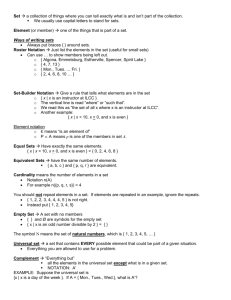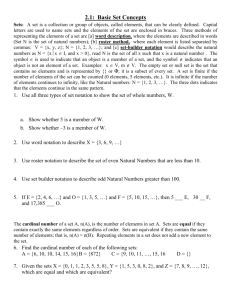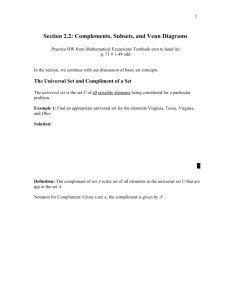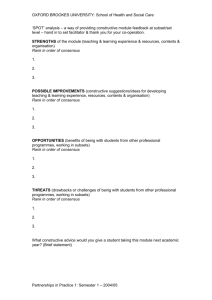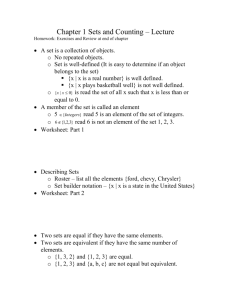Part1Module1
advertisement
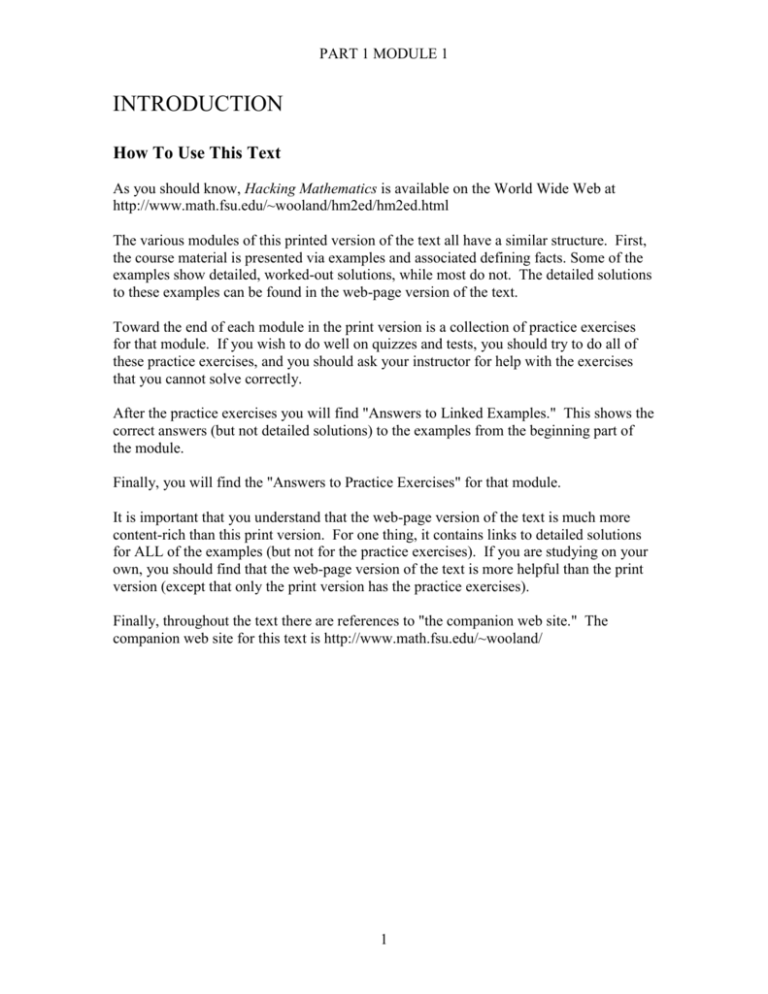
PART 1 MODULE 1
INTRODUCTION
How To Use This Text
As you should know, Hacking Mathematics is available on the World Wide Web at
http://www.math.fsu.edu/~wooland/hm2ed/hm2ed.html
The various modules of this printed version of the text all have a similar structure. First,
the course material is presented via examples and associated defining facts. Some of the
examples show detailed, worked-out solutions, while most do not. The detailed solutions
to these examples can be found in the web-page version of the text.
Toward the end of each module in the print version is a collection of practice exercises
for that module. If you wish to do well on quizzes and tests, you should try to do all of
these practice exercises, and you should ask your instructor for help with the exercises
that you cannot solve correctly.
After the practice exercises you will find "Answers to Linked Examples." This shows the
correct answers (but not detailed solutions) to the examples from the beginning part of
the module.
Finally, you will find the "Answers to Practice Exercises" for that module.
It is important that you understand that the web-page version of the text is much more
content-rich than this print version. For one thing, it contains links to detailed solutions
for ALL of the examples (but not for the practice exercises). If you are studying on your
own, you should find that the web-page version of the text is more helpful than the print
version (except that only the print version has the practice exercises).
Finally, throughout the text there are references to "the companion web site." The
companion web site for this text is http://www.math.fsu.edu/~wooland/
1
PART 1 MODULE 1
PART 1 MODULE 1
Set Mathematics
Sets, Elements, Subsets
Any collection of objects can be considered to be a set.
We can define particular sets by listing the objects in each set. It is conventional to use
set braces when doing so.
Examples of sets:
{a, b, c, d, e, f}
{4, 9, 2, 7}
{Larry, Moe, Curly}
{cat, dog}
{1, 2, 3, 4, 5, 6, 7, ...}
{the people in this room}
NAMES FOR SETS
We will typically use upper case letters for the names of sets.
Let
A = {a, b, c, d, e, f}
B = {4, 9, 2, 7}
C = {Larry, Moe, Curly}
D = {cat, dog}
N = {1, 2, 3, 4, 5, 6, 7, ...}
F = {the people in this room}
Note: the set {1, 2, 3, 4, 5, 6, 7, ...} is very familiar to mathematicians and students of
mathematics. It is usually called the set of natural numbers.
2
PART 1 MODULE 1
ELEMENTS OR MEMBERS OF SETS
The contents of a set are called its elements or members.
We say "9 is an element of B"
"cat is an element of D"
Notation:
9B
cat D
Likewise:
6 is not an element of B
dog is not an element of A
6B
dog A
The CARDINALITY of a set is the number of elements in the set.
In general the cardinality of a set S is denoted n(S).
For example, the cardinality of set B is 4.
Notation:
n(B) = 4
Likewise n(A) = 6
n(D) = 2
n(F) is _____
n(N) is infinity?
SET EQUALITY
In any area of mathematics, a key goal is to determine when two objects that may look
different from one another are actually the same object. In set mathematics, equality is
defined in terms of the contents of sets:
Two sets are said to be equal if they contain exactly the same elements.
Examples
{a, b, c} = {b, c, a}
{4, 2, 7, 9} = B
3
PART 1 MODULE 1
On the other hand:
{1, 2, 3, 4} B
{Larry, Moe} C
A formal definition of set equality is this:
Sets S and T are equal if every element of S is an element of T and every element of T is
an element of S.
SET-BUILDER NOTATION
is a formalistic way of describing the elements of a set without listing them all. It is
useful in some cases where a less formal description might be ambiguous. Here is an
example of set-builder notation:
EXAMPLE 1.1.1
F = {x|x is a person in this room}
We read this as follows:
"F is the set of all x such that x is a person in this room"
Notice that in set-builder notation the construction “{x|x...” is associated with the phrase
“the set of all x such that...” This phrase is then followed by a description or
characteristic that categorizes all the elements of the set. It has nothing to do with
whether to symbol “x” is one of the elements of the set.
More examples of set-builder notation:
N = {x|x is a positive integer}
"N is the set of all x such that x is a positive integer"
New set:
E = {x|x is a positive even number}
List the elements of E.
4
PART 1 MODULE 1
SUBSETS
Let A = {a, b, c, d, e, f}
B = {4, 9, 2, 7}
C = {Larry, Moe, Curly}
D = {cat, dog}
E = {2, 4, 6, 8, 10, ...}
N = {1, 2, 3, 4, 5, 6, 7, ...}
F = {x|x is a person in this room}
G = {b, c, f}
Notice, for instance, that every element of G is also an element of A.
In a case like this we say "G is a subset of A"
Notation:
GA
Likewise,
BN
A formal definition of the word subset is this:
For sets S and T, S is a subset of T if every element of S is also an element of T.
This means that S is contained within T.
Example
{cat} D
A {a, b, c, d, e, f, g, h}
F{x|x is a person in this building}
Formally: S is not a subset of T if there is at least one element of S that is not an element
of T.
5
PART 1 MODULE 1
EXAMPLE 1.1.2
Referring to the sets listed earlier, determine whether each statement is true or false.
1. 7 B
2. n(A) = a
3. B N
4. dog D
5. {7}B
6. {6, 8, 10} E
7. {6, 8, 10}{6, 8, 10}
Exercise #7 above illustrates a general fact about subsets:
Every set is a subset of itself.
6
PART 1 MODULE 1
PROPER SUBSETS
If S is a subset of T but is not equal to T, we say that S is a proper subset of T.
Notation: S T
Examples:
{2, 9} B
{1, 3, 5, 7, 9...} N
{dog, cat} D
The last example illustrates this basic fact:
No set is a proper subset of itself.
COMPLEMENTS, THE UNIVERSAL SET, AND THE EMPTY SET
Consider the set S = {Moe, Larry}
Suppose we want to complete the following exercise:
List all of the elements that are NOT in S.
Are we supposed to list...
...the names of all film performers except Moe and Larry?
...the names of all stooges except Moe and Larry?
...every object on Earth except Moe and Larry?
Unless we establish some boundaries on the scope of this exercise, we cannot make sense
of it.
To establish a frame of reference for a set problem, we can define a universal set (U) for
the problem:
For any set problem or discussion, a universal set (U) is a "larger" set that contains all
of the elements that may be of interest in the discussion; in particular, the universal set at
least contains all of the elements of all of the sets in the discussion.
Returning to the example at hand:
Let U = {Moe, Larry, Curly, Shemp, Curly Joe}
Then to list the elements that are not in S, we list those elements of U that are not in S:
{Curly, Shemp, Curly Joe}
This set is called the complement of S, and is denoted S.
THE EMPTY SET
There is a unique set that contains no elements. It is called the empty set or the null set
or the void set.
The empty set is usually denoted with one of these symbols: { } or
7
PART 1 MODULE 1
EXAMPLE 1.1.3
Let U = {1, 2, 3, 4, 5, 6, 7, 8, 9, 10}
X = {2, 4, 6, 8, 10}
W = {x|x is an odd number}
Y = {3}
True or false:
1. X = W
2. YW
3. YW
4. X U
5. { } X
Exercises #4 and #5 above illustrate the following:
FACT
In any set problem, every set is a subset of U, and { } is a subset of every set.
WORLD WIDE WEB NOTE
For practice on problems involving sets, elements, subsets and the empty set, visit the
companion website and try THE SETS APPEALER.
THE NUMBER OF SUBSETS IN A FINITE SET
General observation: It makes sense to assume that the more elements a set has, the more
subsets it will have.
For finite sets, there is a strict relationship between the cardinality of a set and the
number of subsets . We can discover this relationship by filling in the following table:
S
n(S)
Subsets of S
{}
{a}
{a,b}
{a, b, c}
{a, b, c, d}
{a, b, c, d, e}
8
Number of
subsets
PART 1 MODULE 1
The completed table above suggests the following general fact:
THE NUMBER OF SUBSETS IN A FINITE SET
If n(S) = k, then the number of subsets in S is 2k.
EXAMPLE 1.1.4.A
Let A = {a, b, c, d, e, f} How many subsets does A have?
SOLUTION
Since n(A) = 6, A has 26 subsets. That is, A has 64 subsets (26 = 64).
EXAMPLE 1.1.4.B
Referring to set A above, how many proper subsets does A have?
SOLUTION
We already know that A has 64 subsets. Of those 64 subsets, the only one that is not a
proper subset is set A itself (recall that while every set is a subset of itself, no set is a
proper subset of itself). Thus, A has 63 proper subsets. This example suggests the
following general fact:
For any finite set, the number of proper subsets is one less than the number of subsets.
EXAMPLE 1.1.5
Let U = {1, 2, 3, 4, 5, 6, 7,...}
Let S = {x|x is less than 10}
1. How many subsets does S have?
2. How many proper subsets does S have?
WORLD WIDE WEB NOTE
For exercises involving the number of subsets and the number of proper subsets, visit the
companion website and try THE SUBSETIZER.
9
PART 1 MODULE 1
PRACTICE EXERCISES
1 – 17: Decide whether each statement is true or false.
Let U = { 1, 2, 3, 4, 5, 6, 7 } S = {1, 2, 4, 7}
T = {1, 2, 4, 5, 6, 7}
V = {4, 5, 6}
1. S T
2. n(S) = 7 3. 4V
4. T V
6. {2, 4, 6} = {x|x is an even number}
7. T { }
9. T has 36 subsets
10. V has 7 proper subsets
12. V = {x|x > 3}
13. V = {1, 2,3}
15. {1} T
16. {1} T
5. S T
8. 7 T
11. { } V
14. {7, 4, 2, 1} = S
17. V {5, 6}
ANSWERS TO LINKED EXAMPLES
EXAMPLE 1.1.2
1. True
2. False
7. True
EXAMPLE 1.1.3
1. True
2. True
3. True
4. False
5. False
3. True
4. True
5. True
EXAMPLE 1.1.5
1. 512
2. 511
ANSWERS TO PRACTICE EXERCISES
1. True
2. False
3. False
4. False
6. True
7. False
8. True
9. False
11. True
12. False
13. False
14. True
16. True
17. False
10
5. True
10. True
15. True
6. True
PART 1 MODULE 1
11
